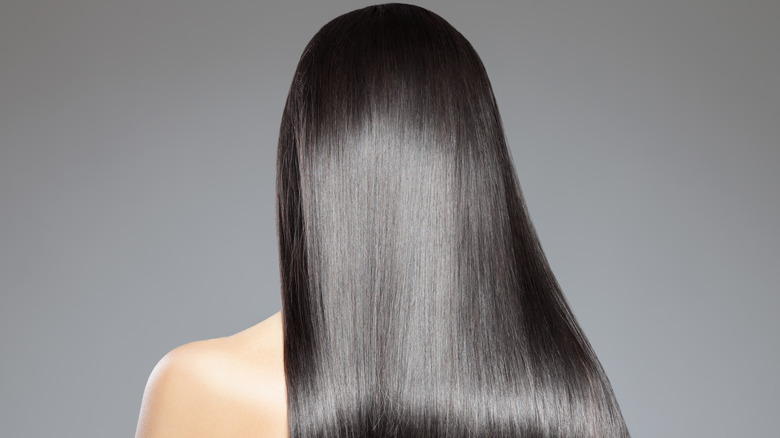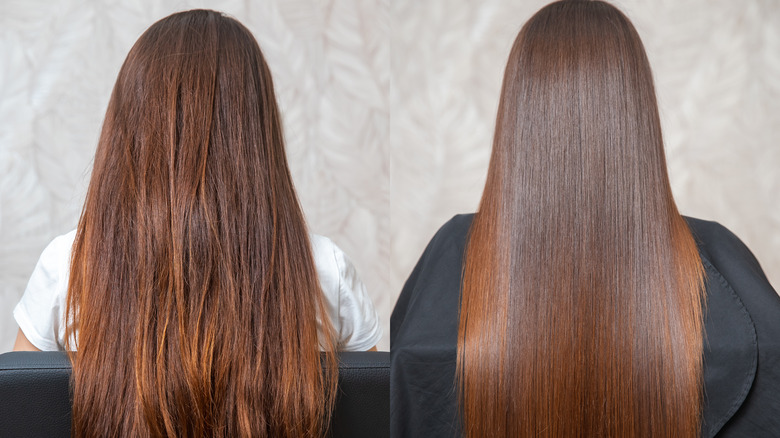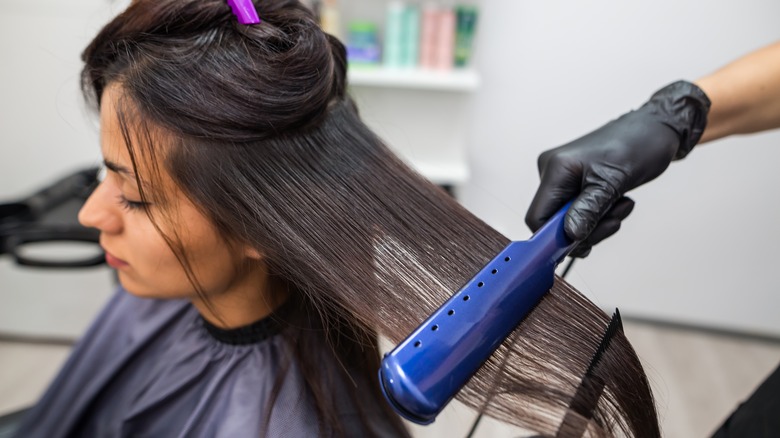Japanese Hair Straightening Could Be The Key To Sleeker Locks
If you have curly or wavy hair and long for sleek, straight locks without the constant use of heating tools, you may be considering permanent hair straightening methods. One of the most well-known techniques is Japanese hair straightening, which became popular in the early 2000s, according to Byrdie. However, Cosmopolitan claims it actually started back in the 1990s. Regardless, it has continued to be a popular option for women seeking straight hair.
Japanese hair straightening, also referred to as thermal reconditioning, uses a chemical to break the bonds of your hair in order to soften it. The result leaves women with a lot less frizz, curls, and waves. At its core, this method of hair straightening is actually quite simple. It is usually complete in just one session with your hairstylist, though it may take several hours, and lasts until your hair starts to grow out again. But before you speed-dial your salon, there is more to know about Japanese hair straightening before determining if it's right for you.
What to consider before getting Japanese hair straightening done
Beach waves, curls, and even hard-to-pull-off pixie cuts have all had their moment to shine, but sleek, straight hair is always on trend, per Byrdie. Those who still fawn over that super-straight look have a few options when it comes to achieving it. You can, of course, flat iron your hair, but doing so every day or flat ironing on wet or over-processed hair are big mistakes when it comes to hair care. An alternative is to head to the salon and get a treatment done. Japanese hair straightening is a permanent treatment, unlike other straightening methods like Keratin, which eventually washes out (via Cosmopolitan). The Japanese method is also much stronger, so if you still want a bit of wave to your hair, you may want to go the Keratin route.
While many people rave about this Japanese straightening treatment, it's important to get it done at the right place. The technique uses harsh chemicals, which, if done incorrectly, can be super damaging to your hair. According to Healthline, it can cause thinning, among other issues, so they recommend testing it on one strand of hair before doing the whole head. If you have the right stylist, though, the result can cut down the time you would usually spend on your hair when getting ready. Also, without the constant use of heating tools, your hair may actually get healthier with time.
The cost and time commitment of Japanese hair straightening
One of the biggest things to consider before getting a Japanese hair straightening treatment is the cost and the time commitment. According to Cosmopolitan, the price of a treatment starts at $700, though Byrdie claims one session is between $400 and $800. The high price makes sense — most people will have straight, sleek hair for about six to ten months before needing a touch-up. In fact, you only need to get a touch-up when your hair starts to grow out, and your natural texture becomes visible again.
You can expect to sit in the salon chair for a few hours while the treatment is applied. Your hairstylist will lock in the treatment with a flat iron once it is finished, per Healthline, and then you should expect to keep it dry for 72 hours — no washing, sweating, or getting caught in the rain. You will also want to keep your hair down and avoid using hair ties or clips for those three days. Japanese hair straightening could be the solution to your frizzy hair problems — just be sure to find the right stylist to do it.


